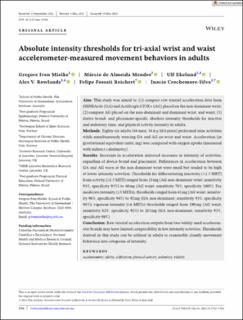| dc.contributor.author | Mielke, Gregore Iven | |
| dc.contributor.author | de Almeida Mendes, Márcio | |
| dc.contributor.author | Ekelund, Ulf | |
| dc.contributor.author | Rowlands, Alex V. | |
| dc.contributor.author | Reichert, Felipe Fossati | |
| dc.contributor.author | Crochemore-Silva, Inacio | |
| dc.date.accessioned | 2023-10-12T12:38:30Z | |
| dc.date.available | 2023-10-12T12:38:30Z | |
| dc.date.created | 2023-06-26T12:05:17Z | |
| dc.date.issued | 2023 | |
| dc.identifier.citation | Scandinavian Journal of Medicine & Science in Sports. 2023, 33(9), Side 1752-1764. | en_US |
| dc.identifier.issn | 0905-7188 | |
| dc.identifier.uri | https://hdl.handle.net/11250/3096131 | |
| dc.description | This is an open access article under the terms of the Creative Commons Attribution License, which permits use, distribution and reproduction in any medium, provided the original work is properly cited. | en_US |
| dc.description.abstract | Aim: This study was aimed to: (1) compare raw triaxial acceleration data from GENEActiv (GA) and ActiGraph GT3X+ (AG) placed on the non-dominant wrist; (2) compare AG placed on the non-dominant and dominant wrist, and waist; (3) derive brand- and placement-specific absolute intensity thresholds for inactive and sedentary time, and physical activity intensity in adults.
Methods: Eighty-six adults (44 men; 34.6 ± 10.8 years) performed nine activities while simultaneously wearing GA and AG on wrist and waist. Acceleration (in gravitational equivalent units; mg) was compared with oxygen uptake (measured with indirect calorimetry).
Results: Increases in acceleration mirrored increases in intensity of activities, regardless of device brand and placement. Differences in acceleration between GA and AG worn at the non-dominant wrist were small but tended to be high at lower intensity activities. Thresholds for differentiating inactivity (<1.5 MET) from activity (≥1.5 MET) ranged from 25 mg (AG non-dominant wrist; sensitivity 93%, specificity 95%) to 40 mg (AG waist; sensitivity 78%, specificity 100%). For moderate intensity (≥3 METs), thresholds ranged from 65 mg (AG waist; sensitivity 96%, specificity 94%) to 92 mg (GA non-dominant; sensitivity 93%, specificity 98%); vigorous intensity (≥6 METs) thresholds ranged from 190 mg (AG waist; sensitivity 82%, specificity 92%) to 283 mg (GA non-dominant; sensitivity 93%, specificity 98%).
Conclusion: Raw triaxial acceleration outputs from two widely used accelerometer brands may have limited comparability in low intensity activities. Thresholds derived in this study can be utilized in adults to reasonably classify movement behaviors into categories of intensity. | en_US |
| dc.language.iso | eng | en_US |
| dc.subject | accelerometer | en_US |
| dc.subject | adults | en_US |
| dc.subject | calibration | en_US |
| dc.subject | physical activity | en_US |
| dc.subject | sedentary | en_US |
| dc.subject | validity | en_US |
| dc.title | Absolute intensity thresholds for tri-axial wrist and waist accelerometer-measured movement behaviors in adults | en_US |
| dc.type | Peer reviewed | en_US |
| dc.type | Journal article | en_US |
| dc.description.version | publishedVersion | en_US |
| dc.rights.holder | © 2023 The Authors | en_US |
| dc.source.pagenumber | 1752-1764 | en_US |
| dc.source.volume | 33 | en_US |
| dc.source.journal | Scandinavian Journal of Medicine & Science in Sports | en_US |
| dc.source.issue | 9 | en_US |
| dc.identifier.doi | 10.1111/sms.14416 | |
| dc.identifier.cristin | 2157953 | |
| dc.description.localcode | Institutt for idrettsmedisinske fag / Department of Sports Medicine | en_US |
| cristin.ispublished | true | |
| cristin.fulltext | original | |
| cristin.qualitycode | 1 | |
